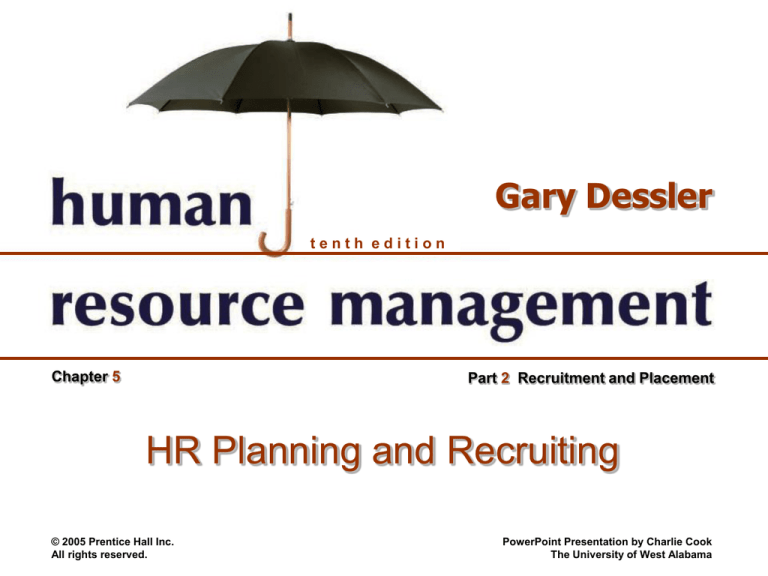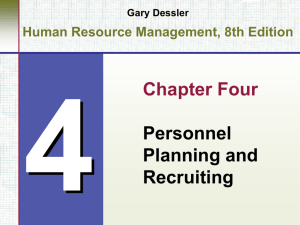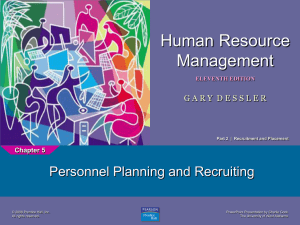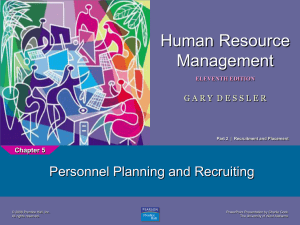
Gary Dessler
tenth edition
Chapter 5
Part 2 Recruitment and Placement
HR Planning and Recruiting
© 2005 Prentice Hall Inc.
All rights reserved.
PowerPoint Presentation by Charlie Cook
The University of West Alabama
Internal Sources of Candidates: Hiring
from Within
Advantages
– Foreknowledge of
candidates’ strengths
and weaknesses
– More accurate view of
candidate’s skills
– Candidates have a
stronger commitment
to the company
– Increases employee
morale
– Less training and
orientation required
© 2005 Prentice Hall Inc. All rights reserved.
Disadvantages
– Failed applicants
become discontented
– Time wasted
interviewing inside
candidates who will not
be considered
– Inbreeding of the
status quo
5–2
Finding Internal Candidates
Job posting
– Publicizing an open job to employees (often by
literally posting it on bulletin boards) and listing its
attributes.
Rehiring former employees
– Advantages:
• They are known quantities.
• They know the firm and its culture.
– Disadvantages:
• They may have less-than positive attitudes.
• Rehiring may sent the wrong message to current
employees about how to get ahead.
© 2005 Prentice Hall Inc. All rights reserved.
5–3
Finding Internal Candidates (cont’d)
Succession planning
– The process of ensuring a suitable supply of
successors for current and future senior or key
jobs.
Succession planning steps:
– Identifying and analyzing key jobs.
– Creating and assessing candidates.
– Selecting those who will fill the key positions.
© 2005 Prentice Hall Inc. All rights reserved.
5–4
Outside Sources of Candidates
Advertising
– The Media: selection of the best medium depends
on the positions for which the firm is recruiting.
•
•
•
•
Newspapers (local and specific labor markets)
Trade and professional journals
Internet job sites
Marketing programs
Constructing an effective ad
– Wording related to job interest factors should
evoke the applicant’s attention, interest, desire,
and action (AIDA) and create a positive
impression of the firm.
© 2005 Prentice Hall Inc. All rights reserved.
5–5
Help
Wanted
Ad
Source: The Miami Herald, March 24, 2004, p. SF.
© 2005 Prentice Hall Inc. All rights reserved.
Figure 5–7
5–6
Outside Sources of Candidates (cont’d)
Types of employment agencies:
– Public agencies operated by federal, state, or local
governments
– Agencies associated with nonprofit organizations
– Privately owned agencies
© 2005 Prentice Hall Inc. All rights reserved.
5–7
Outside Sources of Candidates (cont’d)
Reasons for using a private employment agency:
– When a firm doesn’t have an HR department and is not
geared to doing recruiting and screening.
– The firm has found it difficult in the past to generate a pool
of qualified applicants.
– The firm must fill a particular opening quickly.
– There is a perceived need to attract a greater number of
minority or female applicants.
– The firm wants to reach currently employed individuals, who
might feel more comfortable dealing with agencies than with
competing companies.
– The firm wants to cut down on the time it’s devoting to
recruiting.
© 2005 Prentice Hall Inc. All rights reserved.
5–8
Outside Sources of Candidates (cont’d)
Avoiding problems with employment agencies:
– Give the agency an accurate and complete job description.
– Make sure tests, application blanks, and interviews are part
of the agency’s selection process.
– Periodically review data on candidates accepted or rejected
by your firm, and by the agency. Check on the effectiveness
and fairness of the agency’s screening process.
– Screen the agency. Check with other managers or HR people
to find out which agencies have been the most effective at
filling the sorts of positions needed to be filled.
– Review the Internet and a few back issues of the Sunday
classified ads to discover the agencies that handle the
positions to be filled.
© 2005 Prentice Hall Inc. All rights reserved.
5–9
Temp Agencies and Alternative Staffing
Benefits of Temps
– Paid only when
working
– More productive
– No recruitment,
screening, and payroll
administration costs
© 2005 Prentice Hall Inc. All rights reserved.
Costs of Temps
– Fees paid to temp
agencies
– Lack of commitment to
firm
5–10
Concerns of Temp Employees
Treatment by employers in a dehumanizing, impersonal, and
ultimately discouraging way.
Insecurity about their employment and pessimistic about the
future.
Worry about their lack of insurance and pension benefits.
Being misled about their job assignments and in particular about
whether temporary assignments were likely to become full-time
positions.
Being “underemployed” (particularly those trying to return to the
full-time labor market).
In general they were angry toward the corporate world and its
values; participants repeatedly expressed feelings of alienation
and disenchantment.
© 2005 Prentice Hall Inc. All rights reserved.
5–11
Guidelines for Using Temporary Employees
1. Do not train your contingent workers.
2. Do not negotiate the pay rate of your contingent workers.
3. Do not coach or counsel a contingent worker on his/her job performance.
4. Do not negotiate a contingent worker’s vacations or personal time off.
5. Do not routinely include contingent workers in your company’s employee
functions.
6. Do not allow contingent workers to utilize facilities intended for
employees.
7. Do not let managers issue company business cards, nameplates, or
employee badges to contingent workers without HR and legal approval.
8. Do not let managers discuss harassment or discrimination issues with
contingent workers.
9. Do not discuss job opportunities and the contingent worker’s suitability
for them directly.
10. Do not terminate a contingent worker directly.
Source: Adapted from Bohner and Selasco, “Beware the Legal Risks of Hiring Temps,” Workforce, October 2000, p. 53.
© 2005 Prentice Hall Inc. All rights reserved.
Figure 5–8
5–12
Working with a Temp Agency
Invoicing. Get a sample copy of the agency’s invoice. Make sure it fits
your company’s needs.
Time sheets. With temps, the time sheet is not just a verification of
hours worked. Once the worker’s supervisor signs it, it’s usually an
agreement to pay the agency’s fees.
Temp-to-perm policy. What is the policy if the client wants to hire one of
the agency’s temps as a permanent employee?
Recruitment of and benefits for temp employees. Find out how the
agency plans to recruit what sorts of benefits it pays.
Dress code. Specify the attire at each of your offices or plants.
Equal employment opportunity statement. Get a statement from the
agency that it is not discriminating when filling temp orders.
Job description information. Have a procedure whereby you can ensure
the agency understands the job to be filled and the sort of person you
want to fill it.
© 2005 Prentice Hall Inc. All rights reserved.
5–13
Offshoring/Outsourcing White-Collar and
Other Jobs
Specific issues in outsourcing jobs abroad
– Political and military instability
– Likelihood of cultural misunderstandings
– Customers’ security and privacy concerns
– Foreign contracts, liability, and legal concerns
– Special training of foreign employees
– Costs associated with companies supplying foreign
workers
© 2005 Prentice Hall Inc. All rights reserved.
5–14
Outside Sources of Candidates (cont’d)
Executive recruiters (headhunters)
– Special employment agencies retained by
employers to seek out top-management talent for
their clients.
• Contingent-based recruiters collect a fee for their
services when a successful hire is completed.
• Retained executive searchers are paid regardless of the
outcome of the recruitment process.
– Internet technology and specialization trends are
changing how candidates are attracted and how
searches are conducted.
© 2005 Prentice Hall Inc. All rights reserved.
5–15
Guidelines for Choosing a Recruiter
Make sure the firm is capable of conducting a
thorough search.
Meet the individual who will actually handle
your assignment.
Ask how much the search firm charges.
© 2005 Prentice Hall Inc. All rights reserved.
5–16
Outside Sources of Candidates (cont’d)
On demand recruiting services (ODRS)
– A service that provides short-term specialized
recruiting to support specific projects without the
expense of retaining traditional search firms.
© 2005 Prentice Hall Inc. All rights reserved.
5–17
Outside Sources of Candidates (cont’d)
College recruiting
– Recruiting goals
• To determine if the candidate is worthy of further
consideration
• To attract good candidates
– On-site visits
•
•
•
•
•
•
Invitation letters
Assigned hosts
Information package
Planned interviews
Timely employment offer
Follow-up
– Internships
© 2005 Prentice Hall Inc. All rights reserved.
5–18
Outside Sources of Candidates (cont’d)
Employee referrals
– Applicants who are referred to the organization by
current employees
• Referring employees become stakeholders.
• Referral is a cost-effective recruitment program.
• Referral can speed up diversifying the workforce
Walk-ins
– Direct applicants who seek employment with or
without encouragement from other sources.
– Courteous treatment of any applicant is a good
business practice.
© 2005 Prentice Hall Inc. All rights reserved.
5–19
Outside Sources of Candidates (cont’d)
Recruiting via the Internet
– More firms and applicants are utilizing the Internet
in the job search process.
Advantages of Internet recruiting
–
–
–
–
–
–
Cost-effective way to publicize job openings
More applicants attracted over a longer period
Immediate applicant responses
Online prescreening of applicants
Links to other job search sites
Automation of applicant tracking and evaluation
© 2005 Prentice Hall Inc. All rights reserved.
5–20
Selected Recruitment Web Sites
Source: HR Magazine, November 2003.
© 2005 Prentice Hall Inc. All rights reserved.
Figure 5–9
5–21
Ineffective and Effective Web Ads
Figure 5–10
© 2005 Prentice Hall Inc. All rights reserved.
5–22
Issues in Recruiting a More Diverse
Workforce
Single parents
– Providing work schedule flexibility.
Older workers
– Revising polices that make it difficult or
unattractive for older workers to remain employed.
Recruiting minorities and women
– Understanding recruitment barriers.
– Formulating recruitment plans.
– Instituting specific day-to-day programs.
© 2005 Prentice Hall Inc. All rights reserved.
5–23
Issues in Recruiting a More Diverse
Workforce (cont’d)
Welfare-to-work
– Developing pre-training programs to overcome
difficulties in hiring and assimilating persons
previously on welfare.
The disabled
– Developing resources and policies to recruit and
integrate disable persons into the workforce.
© 2005 Prentice Hall Inc. All rights reserved.
5–24
Developing and Using Application Forms
Application form
– The form that provides information on education,
prior work record, and skills.
Uses of information from applications
– Judgments about the applicant’s educational and
experience qualifications
– Conclusions about the applicant’s previous
progress and growth
– Indications of the applicant’s employment stability
– Predictions about which candidate is likely to
succeed on the job
© 2005 Prentice Hall Inc. All rights reserved.
5–25
HR Scorecard
for Hotel Paris
International
Corporation*
Note: *(An abbreviated example showing selected
HR practices and outcomes aimed at implementing
the competitive strategy, “To use superior guest
services to differentiate the Hotel Paris properties
and thus increase the length of stays and the return
rate of guests and thus boost revenues and
profitability”)
Figure 5–11
© 2005 Prentice Hall Inc. All rights reserved.
5–26





